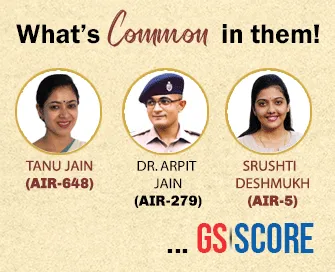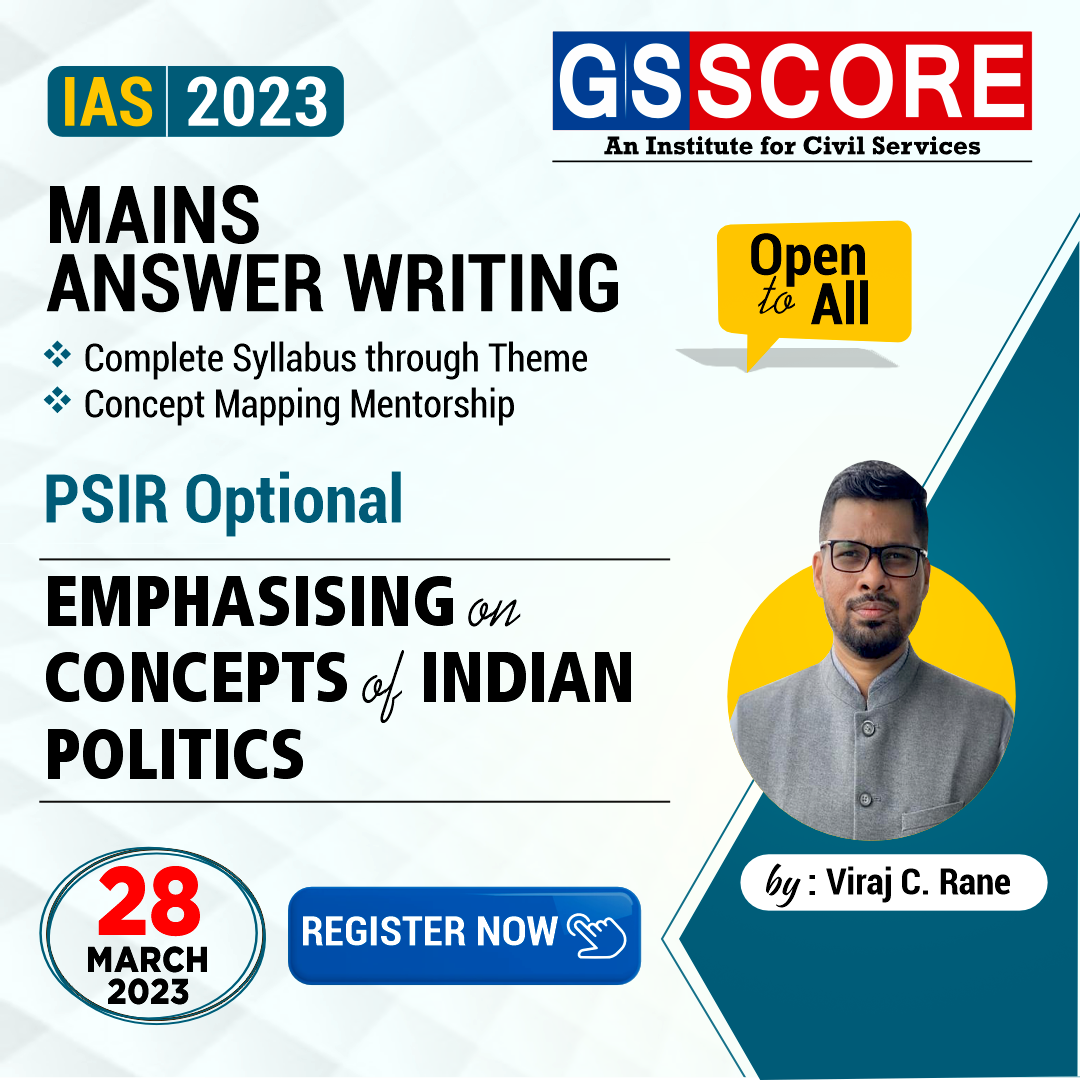


Instruction:
- There will be 2 questions carrying 10 marks each. Write your answers in 150 words
- Any page left blank in the answer-book must be crossed out clearly.
- Evaluated Copy will be re-uploaded on the same thread after 2 days of uploading the copy.
- Discussion of the question and one to one answer improvement session of evaluated copies will be conducted through Google Meet with concerned faculty. You will be informed via mail or SMS for the discussion.
Question #1. Describe the nature of New social movement in India and factors for their limited impact and success till now?
Question #2. Inherent drawbacks and weaknesses of the Indian Electoral system.
(Examiner will pay special attention to the candidate's grasp of his/her material, its relevance to the subject chosen, and to his/ her ability to think constructively and to present his/her ideas concisely, logically and effectively).
STEPS & INSTRUCTIONS for uploading the answers
Step 1 - The Question for the day is provided below these instructions. It will be available at 7:00 AM.
Step 2 - Uploading of Answers : Write the answer in A4 Sheet leaving proper margins for comments and feedback and upload the PDF in MY ACCOUNT section. Click on the option of SUBMIT COPY to upload the PDF.
Step 3 - Deadline for Uploading Answers: The students shall upload their answers by 7:00 PM in the evening same day. The first 50 copies will be evaluated.
Step 4 - Feedback : Mentors will give their feedback for the answers uploaded. For more personalised feedback, join our telegram channel by clicking on the link https://t.me/mains_answer_writing_cse . A one-to-one session will be conducted with the faculty after copy evaluation in 72 Hrs.
Model Answer
Question #1. Describe the nature of New social movement in India and factors for their limited impact and success till now?
Hints:
New social movements in India emerge around new scopes and range of politics. The environment, the rights, and role of women, health, food and nutrition, education, shelter and housing, the dispensation of justice, communications and the dissemination of information, culture and lifestyle, the achievement of peace and disarmament none of which were considered to be subject matter for politics in which ordinary people were involved, are major concerns for the new movements The agenda of new social movement in India generally constitutes the following features:
- They claim to represent the people – the downtrodden Indian masses.
- Most of these movements are against the demerits of globalization.
- They claim to be fighting for oppressed groups such as Dalits and Adivasis.
- They oppose the state as well as large corporations and large funding agencies such as the World Bank. They also oppose large-scale projects. They claim to be fighting for the protection of the environment.
- They criticize the mainstream industrialized, corporate West.
- The new movements reject universal indices of measuring development and progress such as GDP, life expectancy, child mortality, literacy rate, etc. Rather, they argue in favour of subjective and local yardsticks.
How successful have these movements in India been?
- As far as the domain of sustainable development is related, the NSM has achieved a mixed success and its extent of success can definitely be contested since Looking at the movements in India during the immediate post-independence period (democratic regime), most of the environmental movements were suppressed by the postcolonial state. Very few movements were successful.
- Almost all the movements soon after India’s independence during the 1960s and 1970s were suppressed in the name of nation building. However, starting in the mid-1970s, a few movements started to gain success such as the Chipko movement, the Narmada Bachao Andolan (Save Narmada) movement and the Silent Valley movement, when these movements were supported by various national and international human rights groups, environmental groups, NGOs, and activists.
- Coming to the present era of liberalization since the 1990s, a large number of protests and environmental movements have been taking place all over India. Most of the movements are focused on the industrial and mining sectors, which have received a huge amount of foreign investment and have placed a huge impact on the natural environment, where the tribal people’s livelihoods are at stake.
- Although nearly all of the environmental movements have received substantial support from national and international human rights and environmental NGOs and activists, only some of these movements have had any success. An analysis of the movements in Kashipur and Lanjigarh shows that those movements that succeed tend to have the strong support of opposition political parties.
- On the other hand, where there is no support of opposition political parties and there are close ties between the state and transnational corporations, it is easier for the state to suppress environmental movements.
- Since most of the above movements had common memberships in terms of participation of women, Dalits, farmers, tribals etc., the success or failure of each of the above movement can also be attributed as a success or failure of the respective marginalized community in asserting their rights.
- As far as marginalized communities are concerned, success of NSM continues to be a matter of debate .Whereas it has achieved some notable success in context of Dalit and tribal movements by enactment of more relevant laws, policies and programmes but the same continue to suffer from poor implementation and under performance of the programmes.
- Therefore it can be rightly said that the success of these movements in the aforementioned fields still continues to be a contested concept since neither they have the success rates of their contemporary movements in the west nor the same kind of penetration within their target groups so that their efforts would bring a radical change in the situation of the marginalized communities.
Question #2. Inherent drawbacks and weaknesses of the Indian Electoral system.
Hints:
- The discrepancy between the votes cast for a party and the seats won in parliament, the multiplicity of political parties, personality cult in party system, exploitation of caste and communal loyalties, role of muscle and money power, misuse of governmental machinery, fraudulent practices like booth-capturing, intimidation and impersonation of voters are important drawbacks of Indian electoral system.
- Election malpractices range from the physical capturing of booths to the organisation of youth wings of parties or goon squads who could target and terrorise particular communities before the poll to prevent them from voting. Even the poll staff is either bribed into active connivance or intimidated into passive acquiescence. The menace of booth capturing has been in vogue since the second general election of 1957, especially in Bihar. The phenomenon gradually spread over the country in different forms and dimensions.
- The rising need for the muscle power in elections necessitated more input of money too. Earlier voters used to be bribed individually, then it was found to be more convenient to buy musclemen who could ensure victory by capturing booth or intimidating voters rather than buying individual voters. This has led to progressive criminalisation of politics and the emergence of politician under world nexus. Gradually, the criminals themselves have started contesting elections instead of helping others. At times, the politicians found it necessary to politicise the bureaucracy. This can be gauged from the scale on which most of the high officials are changed with the change of a government. This is done to condition the bureaucracy to act in favour of the ruling party during elections. The official machinery is used to collect information on political rivals.
- The official machinery come handy in hiring crowds, intimidating targeted sections of voters, creating local tensions, conditioning staff for poll duties, enrolling additional voters or removing certain names from there, etc. They also, in turn, allow the bureaucracy to make money so that they remain vulnerable. In the process significant sections of bureaucracy get incorporated into the politician-underworld-bureaucracy
- The gap between expenses incurred in an election and legally permitted limit on expenses is also increasing with time. Ceilings on campaign expenses being low, black money in form of donations to election fund of political parties or powerful leaders have come to be an established fact. It is estimated that 90 per cent of all election funds comes from the big business houses in expectation of special favours or patronage. This not only eliminates men and women of ability and integrity from electoral contest for lack of financial support but also promotes criminalization of politics.
Indian Politics is at the core of Paper 2 of PSIR Optional. The topic revolves around a certain concept and having a firm grip over them for the understanding of Indian Politics as a subject is very essential.


